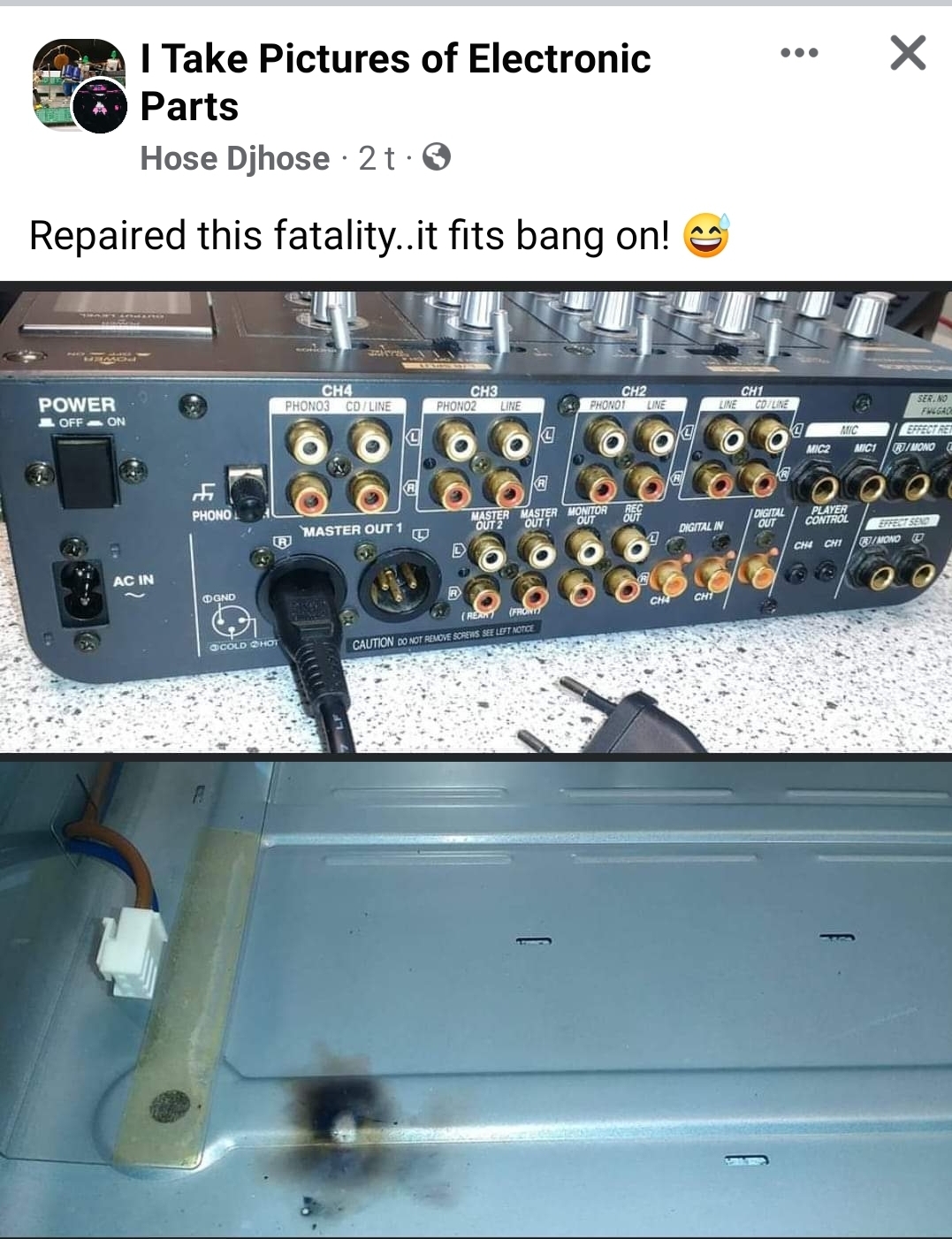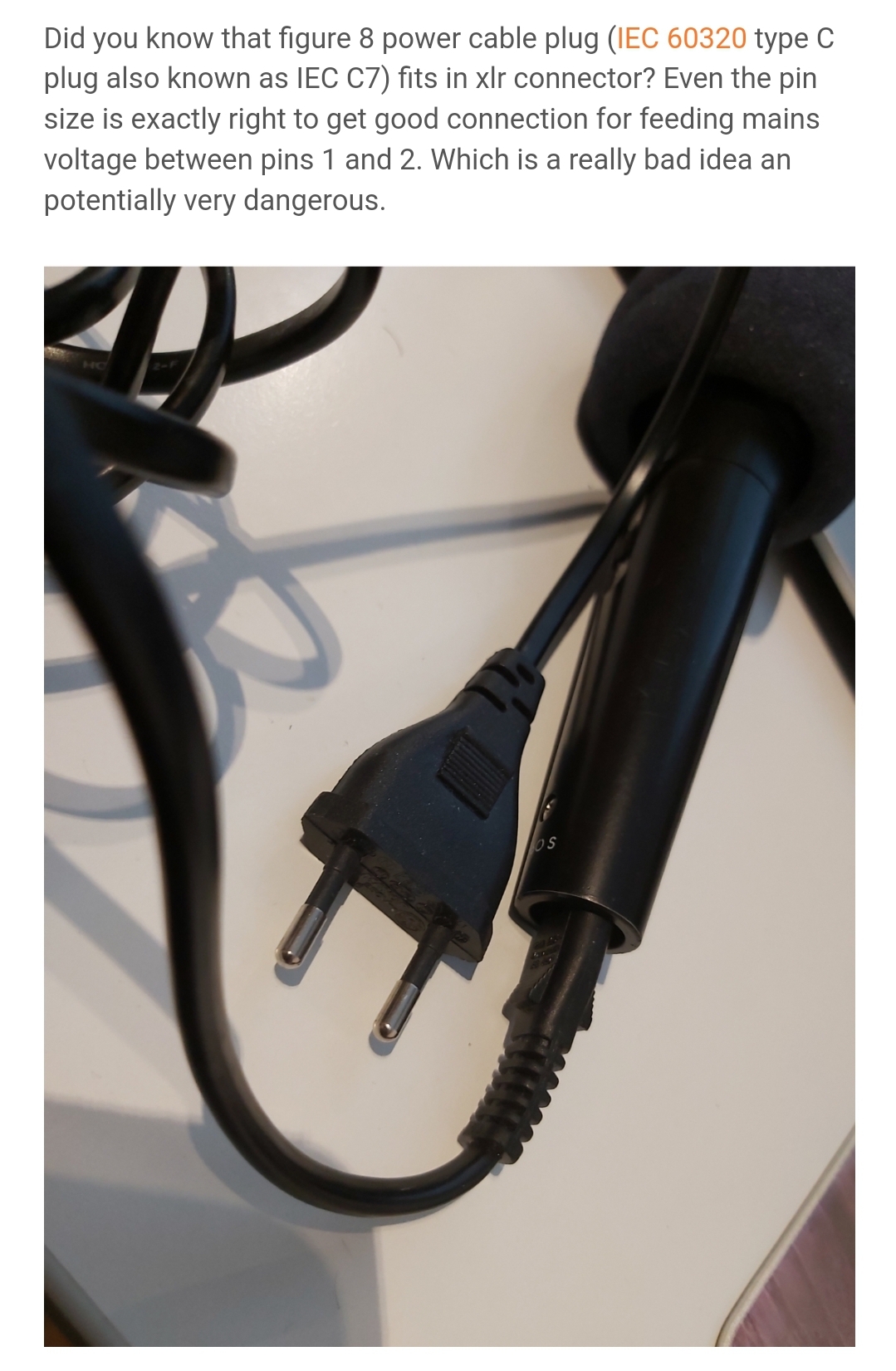Bang on design and use! ‘Forbidden reach around’ Tell people – just because it fits you should not plug it in.
Did you know that figure 8 power cable plug (IEC 60320 type C plug also known as IEC C7) fits into XLR make connector? If it’s round outside, don’t plug an AC cord in, even if it seems to go in. If you do that, you can expect to get disaster result with broken electronics and danger of electrocution. Pins on XLR have the same pitch as mains cable pins. Even the pin size is exactly right to get good connection for feeding mains voltage between XLR pins 1 and 2. Technically it is hot and ground plugged to main live and neutral wires in random order. This is a really bad idea an potentially very dangerous.
There is a good example what kind of damages can happen in this Facebook post that is included here with the permission from the original poster: “Repaired this fatality..it fits bang on! Dude fitted the cable from behind not looking just checking with fingers for right pins…”
This is not the only case where this kind of issues can happen or has happened. There are stories of cd player said bang and let out a nice blue flash. Some claim those accidents to “idiot user” problem, but there are more than that. Mistakes happen when some people do not know too well, are not very careful or need to do plugging in a hurry in environment where they can’t see well and need to go on feeling (for example many live audio setups in dark tight place). It would be better if the mains connector would not easily plug to any other place than mains input socket in he device.
For example Roland RD800 keyboard had the same type issue and the same typo power input was right next to the XLR. Quite a few got blown up so they had to do a recall and they changed the plug on the next version. More information on the recall at https://www.cpsc.gov/Recalls/2014/Roland-Recalls-Digital-Pianos “Hazard:The AC power cord can be connected to the XLR output jacks, posing an electrical shock hazard.”
If you plug the power cord to XLR, what is expected is a bang and let out if some blue flash and maybe some smoke. Depending on which way you plugged in the cord, you could have around 50% change of your equipment metal case to be connected to mains live (which is 230V AC in Europe and 120V AC in USA).
This kind of incidents have been a source of jokes:
You could joke on this incident that here was a DJ that played a banger.
‘Got any AC/DC?’
‘Think I’ve got some AC? I’ll just check’That’s a bit much for phantom power
So what you’re saying is that a figure 8 cable will work as an unbalanced out in a pinch…
Between GND and HOT… It was only 43dBm (120V AC) or 49 dBm (230V AC) of signal level being fed into the output. It will fry the output electronics.
Back to serious business. Let’s analyze what happens when you plug in IEC C7 plug to equipment XLR. Normally with most common EURO plug to IEC C7 power cable, you can plug in the both ends of the cable freely both ways. Same applies also to most US NEMA to C7 cables as well. So the end result is that you have 50% change that mains power NEUTRAL goes to the XLR pin 1 and LIVE goes to the XLR pin 2. The pin 1 in XLR is the ground pin, that is often connected to the equipment metal case (in some cases it could be isolated or connected through ground lift switch). If there is connection from XLR pin 1 to equipment metal case, that means that the equipment case is now connected to mains neutral wire. Not good but usually not very dangerous (because neutral and ground do not normally have very large potential differences). The XLR pin 2 is the signal hot pin that receives the mains LIVE wire voltage (typically around 120V 60 Hz or 230V 50 Hz). When this high voltage hits typical audio equipment output electronics, the result is that the electronics has more or less fried parts and possibly smoke coming out. Depending on case it could be repairable or whole device could be fried beyond repair. In some rare cases the output could survive the abuse (for example some floating output transformer isolated outputs on some old devices).
The other situation when plug is the other way around is where XLR pin is connected to mains LIVE (120V or 230V AC) and the XLR pin 2 is connected to mains NEUTRAL. In this case if the equipment in question does not have any ground connection anywhere (for example through audio cables to other grounded equipment) the equipment metal case is most probably at mains LIVE wire potential. This is very dangerous, and you could be electrocuted by touching the equipment case like you would be by touching a live wire. In addition to this the equipment XLR output electronics would be fried just like in the previous situation.
The third option is that the plug is plugged just like in previous example: XLR pin is connected to mains LIVE (120V or 230V AC) and the XLR pin 2 is connected to mains NEUTRAL. But the equipment metal case has some other ground connection wired to it (separate grounding wire, grounding through audio cables to other equipment, grounding through metal equipment rack rails etc..). This causes that the LIVE will be shorted to the ground. A lot of current will flow though this ground connection until the circuit protective device stops the current flow (circuit breaker, ground fault interrupter or fuse). When large current flows, you could bear strong bang, see sparks and get some sparking damage to connectors. When the current has been stopped by protective device, you will not get any power and no danger anymore. Your other equipment powered by the same mains circuit will most probably also not get any power anymore. Depending how you plugged the mains cable, how quickly the protective devices cut out the power and some other details, you might or might have damaged equipment and/or audio cables.
I see the possibility of able to plug the main cable to the XLR is a serious design flaw. Pins on XLR have the same pitch as mains cable pins. This is mainly a concern with “prosumer” equipment that use IEC C7 mains connector and has male XLRs. I think there are both equipment designers and whoever originally designed this mains connector for the IEC 60320 standard. IEC C7, that is commmonly referred to as “figure 8″ or “infinity”, was originally designed for domestic audio, video, radio equipment and doubly insulated power supplies. I think that IEC standardization organization made a mistake when they approved XLR mating C7 connector to IEC 60320 standard. At the time of the standard, XLR had been in use for more than a decade for professional audio applications (XLR started around 1950 while IEC standard first version is from 1970′s).
For the product designers is why do you design devices that have both C7/C8 mains input and male XLR connectors? And place them near each other on the back of the device that can be in hard to reach and see place? Making such product designs is stupid and has potential dangers to the user.
Most pro gear use grounded three pin IEC C15/C16 or IEC C5/C6 for mains input or fixed mains cable. With those there is no danger of getting accidentally mains to the XLR connector.
I posted this C7 plug fits to XLR male to my blog years ago
https://www.epanorama.net/newepa/2021/04/29/friday-fun-speaker-to-mains-power-disaster-adapters/


8 Comments
Tomi Engdahl says:
How to add blewtooth functionality to an XLR
geometry dash says:
You are providing such an invaluable resource, and yet you are giving it out completely free of charge. I always appreciate it when I come across blogs that recognize the importance of giving out a valuable resource for free.
SkyWard Alpine says:
Thanks for the sharing excellent post.
Tomi Engdahl says:
https://ourdjtalk.com/djchat/a-brief-history-of-the-xlr-connector.51722/
https://service.shure.com/s/article/history-of-the-term-xlr?language=en_US
Tomi Engdahl says:
https://gearspace.com/board/so-much-gear-so-little-time/166423-history-balanced-cables.html
Tomi Engdahl says:
How to add blewtooth functionality to an XLR input
爱思助手 says:
You have done a great job on this article. It’s very readable and highly intelligent. You have even managed to make it understandable and easy to read. You have some real writing talent. Thank you.
向日葵 says:
The website is looking bit flashy and it catches the traffic eyes. layout is beautiful clean and a enjoyable adherent without problems reached interface.